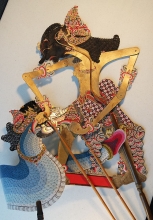Javanese wayang kulit accompanied by the Yale Javanese Gamelan Ensemble
The Javanese wayang kulit or wayang purwå (shadow-play with flat leather puppets) is one of the great dramatic forms of the East. Above and beyond its value as a wonderful entertainment, it is important to the Javanese as a ceremony. It provides a means of contact with the ancestral spirits and establishes an atmosphere of serenity and balance; it is also a means of educating the young in the wisdom of the culture; and it employs, as a frame of reference, philosophical and mystical ideas.
In general, a play falls into three main divisions defined by the planting of the kayon or gunungan (tree or mountain) in the center of the stage, thus marking the line between the forces to the dhalang’s right, usually positive, and the forces of left, usually negative. The dhalang is in complete charge of the performance. During the performance he manipulates the puppets, delivers all the dialogue in many voices, describes the scene, comments on the meaning—often drawing on events of the day—and signals the orchestra what and when to play.
A gamelan (orchestra), using various combinations of instruments, is traditionally and essentially accompaniment to puppet shows, dances, feasts, and ceremonies in Java. Most of the instruments are bronze: tuned gongs, suspended vertically or horizontally; and instruments with tuned keys, suspended over tubular resonators or a resonant cavity in the base of the instrument. Other instruments include a two-stringed fiddle, xylophones, and drums. A full Javanese gamelan comprises two sets of instruments, one in each of two tuning systems: sléndro, with five tones per octave, and pélog, with seven. In this performance, a chamber ensemble of only sléndro set will be used.

